BEC402 Macroeconomics: Malaysia's Economic Trends and Policies Report
VerifiedAdded on 2021/07/20
|16
|3624
|310
Report
AI Summary
This report analyzes Malaysia's macroeconomic performance, focusing on unemployment, inflation, and the impact of government policies. It begins with a background of Malaysia, followed by an analysis of unemployment and inflation trends over the past ten years, supported by data and graphs. The report evaluates the effectiveness of monetary and fiscal policies in achieving macroeconomic objectives. It also assesses the impact of the COVID-19 pandemic on the Malaysian economy, including the causes, effects, advantages, and disadvantages. Finally, it provides a summary of the findings and offers recommendations for improving the country's economy. The report utilizes data, charts, and economic theories to provide a comprehensive overview of Malaysia's economic landscape.
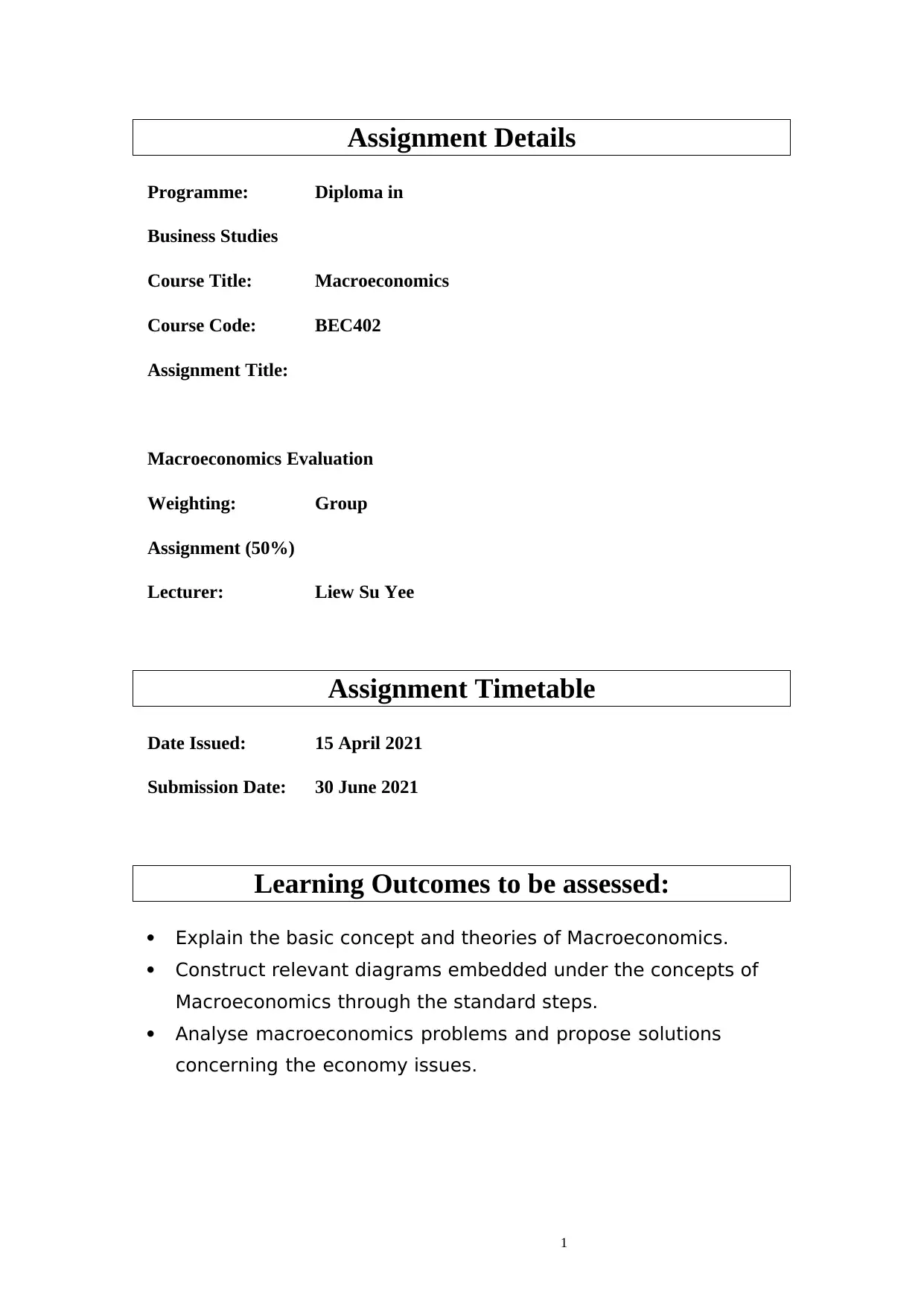
1
Assignment Details
Programme: Diploma in
Business Studies
Course Title: Macroeconomics
Course Code: BEC402
Assignment Title:
Macroeconomics Evaluation
Weighting: Group
Assignment (50%)
Lecturer: Liew Su Yee
Assignment Timetable
Date Issued: 15 April 2021
Submission Date: 30 June 2021
Learning Outcomes to be assessed:
Explain the basic concept and theories of Macroeconomics.
Construct relevant diagrams embedded under the concepts of
Macroeconomics through the standard steps.
Analyse macroeconomics problems and propose solutions
concerning the economy issues.
Assignment Details
Programme: Diploma in
Business Studies
Course Title: Macroeconomics
Course Code: BEC402
Assignment Title:
Macroeconomics Evaluation
Weighting: Group
Assignment (50%)
Lecturer: Liew Su Yee
Assignment Timetable
Date Issued: 15 April 2021
Submission Date: 30 June 2021
Learning Outcomes to be assessed:
Explain the basic concept and theories of Macroeconomics.
Construct relevant diagrams embedded under the concepts of
Macroeconomics through the standard steps.
Analyse macroeconomics problems and propose solutions
concerning the economy issues.
Paraphrase This Document
Need a fresh take? Get an instant paraphrase of this document with our AI Paraphraser
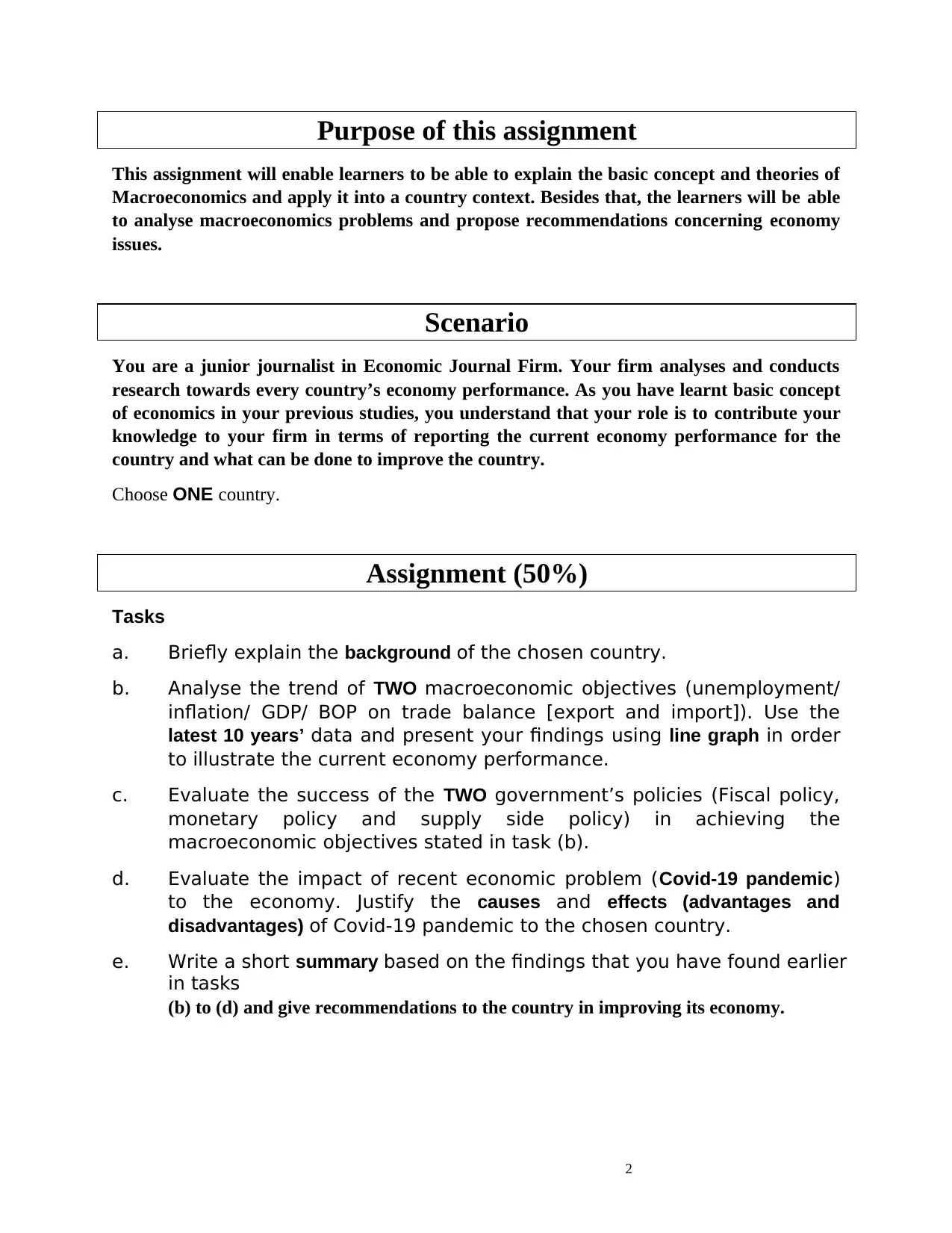
2
Purpose of this assignment
This assignment will enable learners to be able to explain the basic concept and theories of
Macroeconomics and apply it into a country context. Besides that, the learners will be able
to analyse macroeconomics problems and propose recommendations concerning economy
issues.
Scenario
You are a junior journalist in Economic Journal Firm. Your firm analyses and conducts
research towards every country’s economy performance. As you have learnt basic concept
of economics in your previous studies, you understand that your role is to contribute your
knowledge to your firm in terms of reporting the current economy performance for the
country and what can be done to improve the country.
Choose ONE country.
Assignment (50%)
Tasks
a. Briefly explain the background of the chosen country.
b. Analyse the trend of TWO macroeconomic objectives (unemployment/
inflation/ GDP/ BOP on trade balance [export and import]). Use the
latest 10 years’ data and present your findings using line graph in order
to illustrate the current economy performance.
c. Evaluate the success of the TWO government’s policies (Fiscal policy,
monetary policy and supply side policy) in achieving the
macroeconomic objectives stated in task (b).
d. Evaluate the impact of recent economic problem (Covid-19 pandemic)
to the economy. Justify the causes and effects (advantages and
disadvantages) of Covid-19 pandemic to the chosen country.
e. Write a short summary based on the findings that you have found earlier
in tasks
(b) to (d) and give recommendations to the country in improving its economy.
Purpose of this assignment
This assignment will enable learners to be able to explain the basic concept and theories of
Macroeconomics and apply it into a country context. Besides that, the learners will be able
to analyse macroeconomics problems and propose recommendations concerning economy
issues.
Scenario
You are a junior journalist in Economic Journal Firm. Your firm analyses and conducts
research towards every country’s economy performance. As you have learnt basic concept
of economics in your previous studies, you understand that your role is to contribute your
knowledge to your firm in terms of reporting the current economy performance for the
country and what can be done to improve the country.
Choose ONE country.
Assignment (50%)
Tasks
a. Briefly explain the background of the chosen country.
b. Analyse the trend of TWO macroeconomic objectives (unemployment/
inflation/ GDP/ BOP on trade balance [export and import]). Use the
latest 10 years’ data and present your findings using line graph in order
to illustrate the current economy performance.
c. Evaluate the success of the TWO government’s policies (Fiscal policy,
monetary policy and supply side policy) in achieving the
macroeconomic objectives stated in task (b).
d. Evaluate the impact of recent economic problem (Covid-19 pandemic)
to the economy. Justify the causes and effects (advantages and
disadvantages) of Covid-19 pandemic to the chosen country.
e. Write a short summary based on the findings that you have found earlier
in tasks
(b) to (d) and give recommendations to the country in improving its economy.
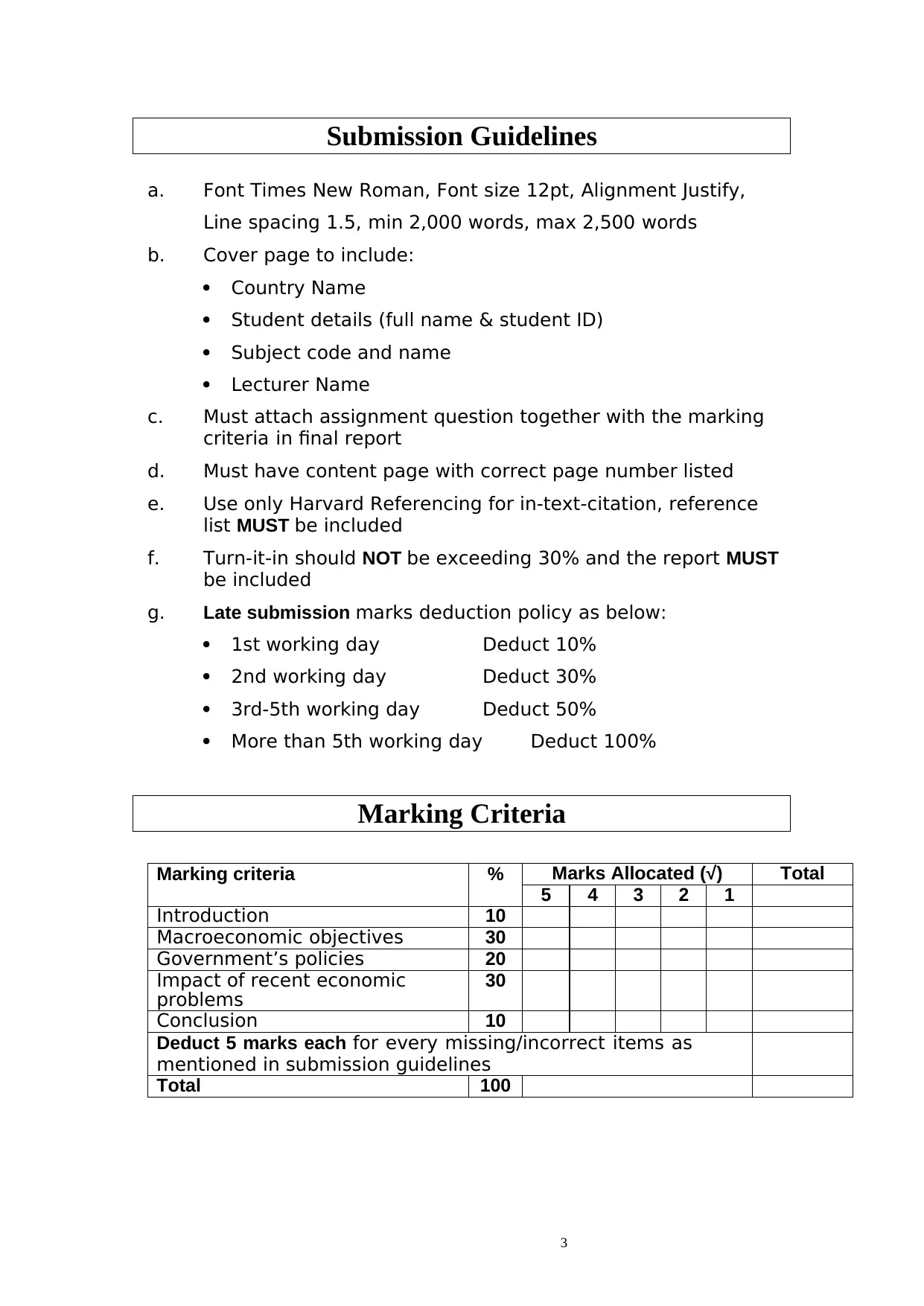
3
Submission Guidelines
a. Font Times New Roman, Font size 12pt, Alignment Justify,
Line spacing 1.5, min 2,000 words, max 2,500 words
b. Cover page to include:
Country Name
Student details (full name & student ID)
Subject code and name
Lecturer Name
c. Must attach assignment question together with the marking
criteria in final report
d. Must have content page with correct page number listed
e. Use only Harvard Referencing for in-text-citation, reference
list MUST be included
f. Turn-it-in should NOT be exceeding 30% and the report MUST
be included
g. Late submission marks deduction policy as below:
1st working day Deduct 10%
2nd working day Deduct 30%
3rd-5th working day Deduct 50%
More than 5th working day Deduct 100%
Marking Criteria
Marking criteria % Marks Allocated (√) Total
5 4 3 2 1
Introduction 10
Macroeconomic objectives 30
Government’s policies 20
Impact of recent economic
problems
30
Conclusion 10
Deduct 5 marks each for every missing/incorrect items as
mentioned in submission guidelines
Total 100
Submission Guidelines
a. Font Times New Roman, Font size 12pt, Alignment Justify,
Line spacing 1.5, min 2,000 words, max 2,500 words
b. Cover page to include:
Country Name
Student details (full name & student ID)
Subject code and name
Lecturer Name
c. Must attach assignment question together with the marking
criteria in final report
d. Must have content page with correct page number listed
e. Use only Harvard Referencing for in-text-citation, reference
list MUST be included
f. Turn-it-in should NOT be exceeding 30% and the report MUST
be included
g. Late submission marks deduction policy as below:
1st working day Deduct 10%
2nd working day Deduct 30%
3rd-5th working day Deduct 50%
More than 5th working day Deduct 100%
Marking Criteria
Marking criteria % Marks Allocated (√) Total
5 4 3 2 1
Introduction 10
Macroeconomic objectives 30
Government’s policies 20
Impact of recent economic
problems
30
Conclusion 10
Deduct 5 marks each for every missing/incorrect items as
mentioned in submission guidelines
Total 100
⊘ This is a preview!⊘
Do you want full access?
Subscribe today to unlock all pages.

Trusted by 1+ million students worldwide

4
Task A
Malaysia’ background
Task A
Malaysia’ background
Paraphrase This Document
Need a fresh take? Get an instant paraphrase of this document with our AI Paraphraser
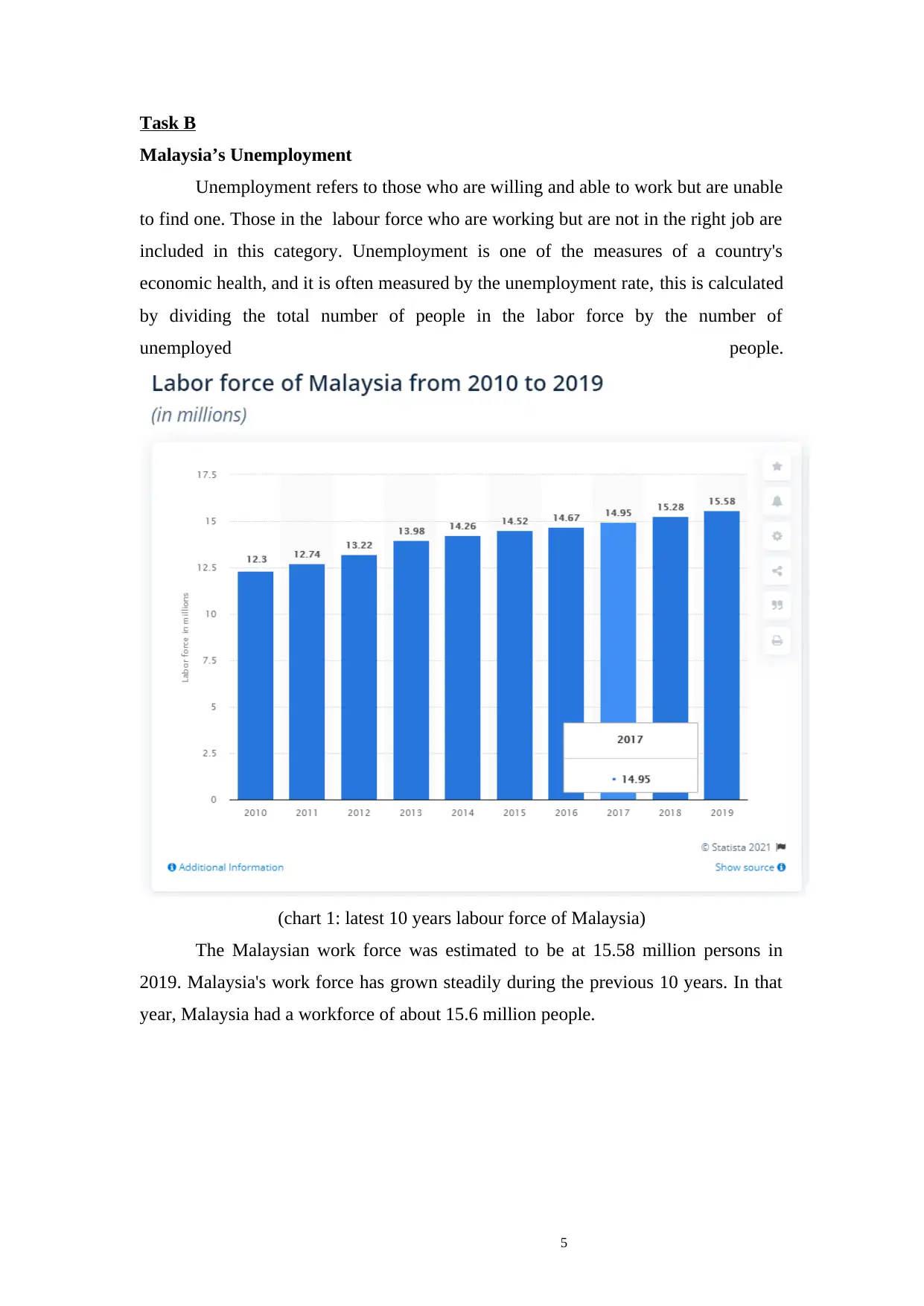
5
Task B
Malaysia’s Unemployment
Unemployment refers to those who are willing and able to work but are unable
to find one. Those in the labour force who are working but are not in the right job are
included in this category. Unemployment is one of the measures of a country's
economic health, and it is often measured by the unemployment rate, this is calculated
by dividing the total number of people in the labor force by the number of
unemployed people.
(chart 1: latest 10 years labour force of Malaysia)
The Malaysian work force was estimated to be at 15.58 million persons in
2019. Malaysia's work force has grown steadily during the previous 10 years. In that
year, Malaysia had a workforce of about 15.6 million people.
Task B
Malaysia’s Unemployment
Unemployment refers to those who are willing and able to work but are unable
to find one. Those in the labour force who are working but are not in the right job are
included in this category. Unemployment is one of the measures of a country's
economic health, and it is often measured by the unemployment rate, this is calculated
by dividing the total number of people in the labor force by the number of
unemployed people.
(chart 1: latest 10 years labour force of Malaysia)
The Malaysian work force was estimated to be at 15.58 million persons in
2019. Malaysia's work force has grown steadily during the previous 10 years. In that
year, Malaysia had a workforce of about 15.6 million people.
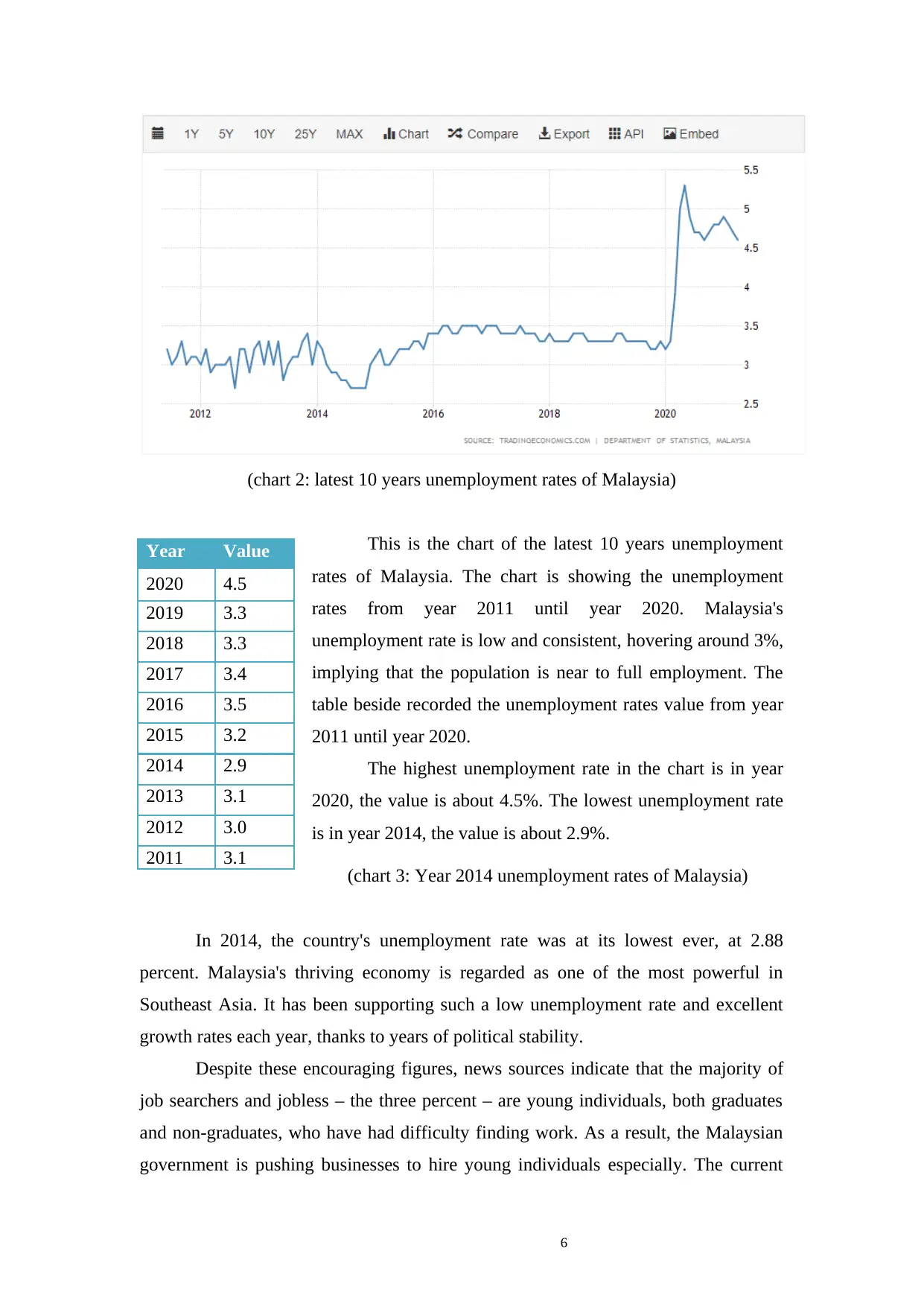
6
(chart 2: latest 10 years unemployment rates of Malaysia)
This is the chart of the latest 10 years unemployment
rates of Malaysia. The chart is showing the unemployment
rates from year 2011 until year 2020. Malaysia's
unemployment rate is low and consistent, hovering around 3%,
implying that the population is near to full employment. The
table beside recorded the unemployment rates value from year
2011 until year 2020.
The highest unemployment rate in the chart is in year
2020, the value is about 4.5%. The lowest unemployment rate
is in year 2014, the value is about 2.9%.
(chart 3: Year 2014 unemployment rates of Malaysia)
In 2014, the country's unemployment rate was at its lowest ever, at 2.88
percent. Malaysia's thriving economy is regarded as one of the most powerful in
Southeast Asia. It has been supporting such a low unemployment rate and excellent
growth rates each year, thanks to years of political stability.
Despite these encouraging figures, news sources indicate that the majority of
job searchers and jobless – the three percent – are young individuals, both graduates
and non-graduates, who have had difficulty finding work. As a result, the Malaysian
government is pushing businesses to hire young individuals especially. The current
Year Value
2020 4.5
2019 3.3
2018 3.3
2017 3.4
2016 3.5
2015 3.2
2014 2.9
2013 3.1
2012 3.0
2011 3.1
(chart 2: latest 10 years unemployment rates of Malaysia)
This is the chart of the latest 10 years unemployment
rates of Malaysia. The chart is showing the unemployment
rates from year 2011 until year 2020. Malaysia's
unemployment rate is low and consistent, hovering around 3%,
implying that the population is near to full employment. The
table beside recorded the unemployment rates value from year
2011 until year 2020.
The highest unemployment rate in the chart is in year
2020, the value is about 4.5%. The lowest unemployment rate
is in year 2014, the value is about 2.9%.
(chart 3: Year 2014 unemployment rates of Malaysia)
In 2014, the country's unemployment rate was at its lowest ever, at 2.88
percent. Malaysia's thriving economy is regarded as one of the most powerful in
Southeast Asia. It has been supporting such a low unemployment rate and excellent
growth rates each year, thanks to years of political stability.
Despite these encouraging figures, news sources indicate that the majority of
job searchers and jobless – the three percent – are young individuals, both graduates
and non-graduates, who have had difficulty finding work. As a result, the Malaysian
government is pushing businesses to hire young individuals especially. The current
Year Value
2020 4.5
2019 3.3
2018 3.3
2017 3.4
2016 3.5
2015 3.2
2014 2.9
2013 3.1
2012 3.0
2011 3.1
⊘ This is a preview!⊘
Do you want full access?
Subscribe today to unlock all pages.

Trusted by 1+ million students worldwide
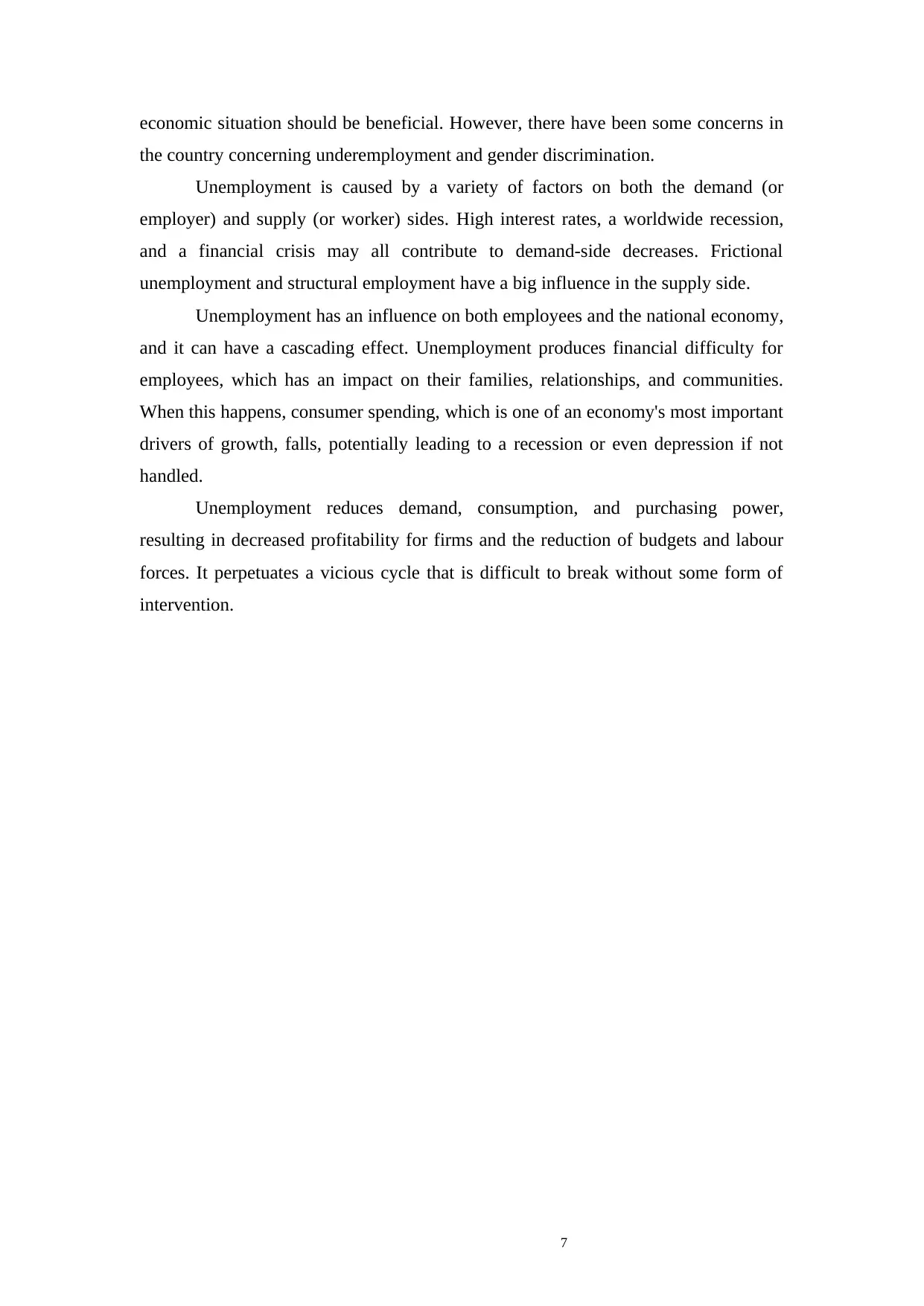
7
economic situation should be beneficial. However, there have been some concerns in
the country concerning underemployment and gender discrimination.
Unemployment is caused by a variety of factors on both the demand (or
employer) and supply (or worker) sides. High interest rates, a worldwide recession,
and a financial crisis may all contribute to demand-side decreases. Frictional
unemployment and structural employment have a big influence in the supply side.
Unemployment has an influence on both employees and the national economy,
and it can have a cascading effect. Unemployment produces financial difficulty for
employees, which has an impact on their families, relationships, and communities.
When this happens, consumer spending, which is one of an economy's most important
drivers of growth, falls, potentially leading to a recession or even depression if not
handled.
Unemployment reduces demand, consumption, and purchasing power,
resulting in decreased profitability for firms and the reduction of budgets and labour
forces. It perpetuates a vicious cycle that is difficult to break without some form of
intervention.
economic situation should be beneficial. However, there have been some concerns in
the country concerning underemployment and gender discrimination.
Unemployment is caused by a variety of factors on both the demand (or
employer) and supply (or worker) sides. High interest rates, a worldwide recession,
and a financial crisis may all contribute to demand-side decreases. Frictional
unemployment and structural employment have a big influence in the supply side.
Unemployment has an influence on both employees and the national economy,
and it can have a cascading effect. Unemployment produces financial difficulty for
employees, which has an impact on their families, relationships, and communities.
When this happens, consumer spending, which is one of an economy's most important
drivers of growth, falls, potentially leading to a recession or even depression if not
handled.
Unemployment reduces demand, consumption, and purchasing power,
resulting in decreased profitability for firms and the reduction of budgets and labour
forces. It perpetuates a vicious cycle that is difficult to break without some form of
intervention.
Paraphrase This Document
Need a fresh take? Get an instant paraphrase of this document with our AI Paraphraser
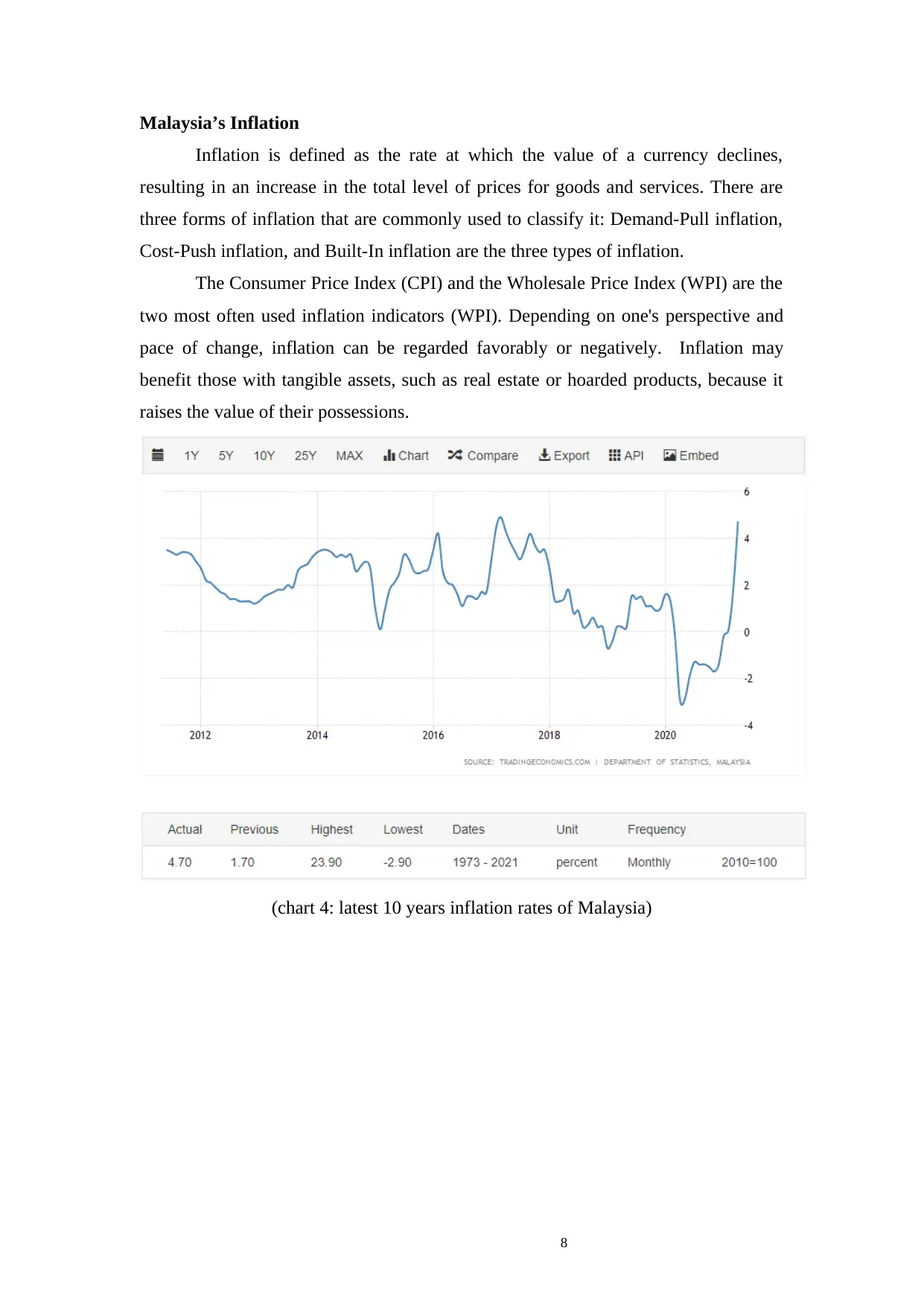
8
Malaysia’s Inflation
Inflation is defined as the rate at which the value of a currency declines,
resulting in an increase in the total level of prices for goods and services. There are
three forms of inflation that are commonly used to classify it: Demand-Pull inflation,
Cost-Push inflation, and Built-In inflation are the three types of inflation.
The Consumer Price Index (CPI) and the Wholesale Price Index (WPI) are the
two most often used inflation indicators (WPI). Depending on one's perspective and
pace of change, inflation can be regarded favorably or negatively. Inflation may
benefit those with tangible assets, such as real estate or hoarded products, because it
raises the value of their possessions.
(chart 4: latest 10 years inflation rates of Malaysia)
Malaysia’s Inflation
Inflation is defined as the rate at which the value of a currency declines,
resulting in an increase in the total level of prices for goods and services. There are
three forms of inflation that are commonly used to classify it: Demand-Pull inflation,
Cost-Push inflation, and Built-In inflation are the three types of inflation.
The Consumer Price Index (CPI) and the Wholesale Price Index (WPI) are the
two most often used inflation indicators (WPI). Depending on one's perspective and
pace of change, inflation can be regarded favorably or negatively. Inflation may
benefit those with tangible assets, such as real estate or hoarded products, because it
raises the value of their possessions.
(chart 4: latest 10 years inflation rates of Malaysia)
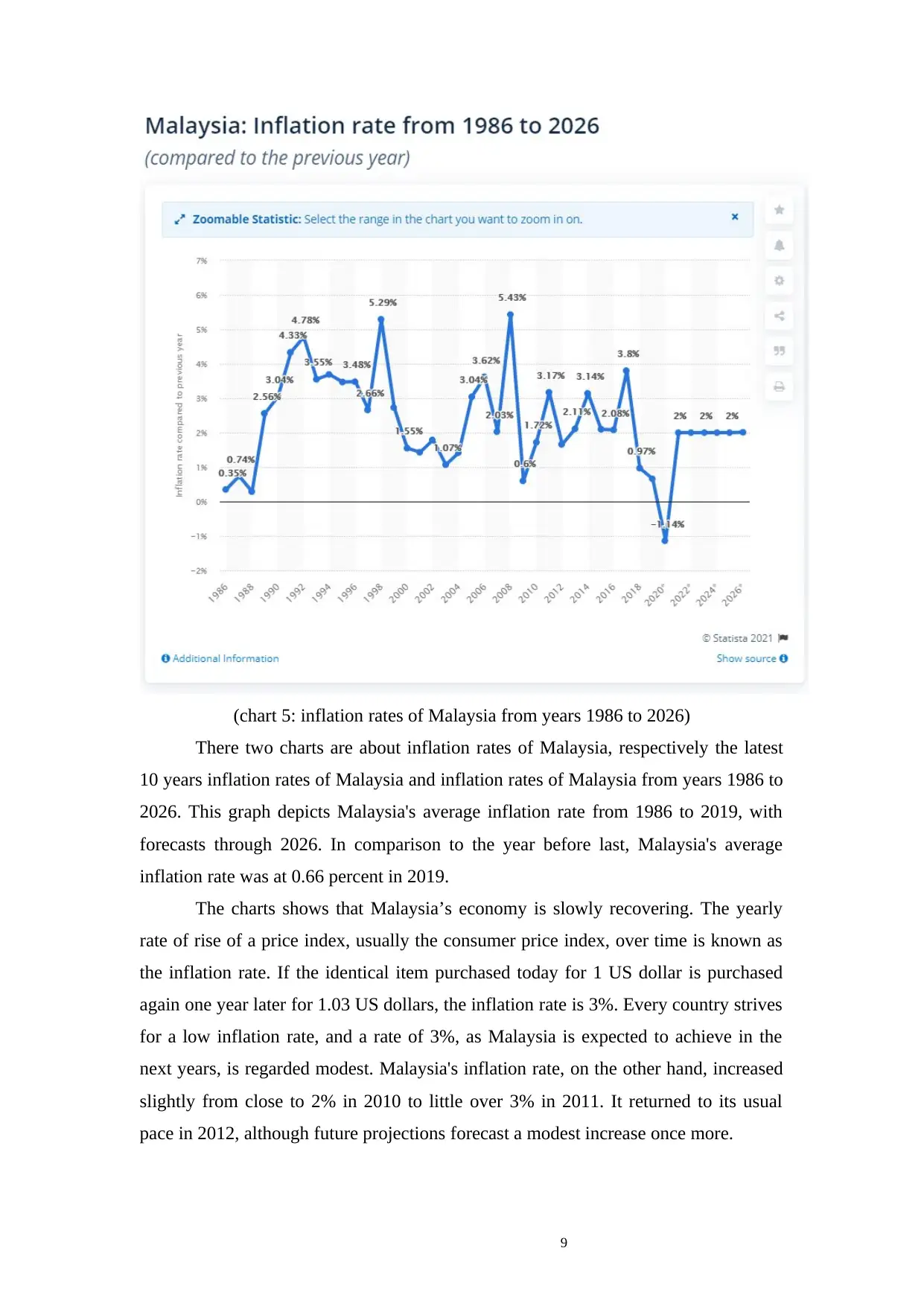
9
(chart 5: inflation rates of Malaysia from years 1986 to 2026)
There two charts are about inflation rates of Malaysia, respectively the latest
10 years inflation rates of Malaysia and inflation rates of Malaysia from years 1986 to
2026. This graph depicts Malaysia's average inflation rate from 1986 to 2019, with
forecasts through 2026. In comparison to the year before last, Malaysia's average
inflation rate was at 0.66 percent in 2019.
The charts shows that Malaysia’s economy is slowly recovering. The yearly
rate of rise of a price index, usually the consumer price index, over time is known as
the inflation rate. If the identical item purchased today for 1 US dollar is purchased
again one year later for 1.03 US dollars, the inflation rate is 3%. Every country strives
for a low inflation rate, and a rate of 3%, as Malaysia is expected to achieve in the
next years, is regarded modest. Malaysia's inflation rate, on the other hand, increased
slightly from close to 2% in 2010 to little over 3% in 2011. It returned to its usual
pace in 2012, although future projections forecast a modest increase once more.
(chart 5: inflation rates of Malaysia from years 1986 to 2026)
There two charts are about inflation rates of Malaysia, respectively the latest
10 years inflation rates of Malaysia and inflation rates of Malaysia from years 1986 to
2026. This graph depicts Malaysia's average inflation rate from 1986 to 2019, with
forecasts through 2026. In comparison to the year before last, Malaysia's average
inflation rate was at 0.66 percent in 2019.
The charts shows that Malaysia’s economy is slowly recovering. The yearly
rate of rise of a price index, usually the consumer price index, over time is known as
the inflation rate. If the identical item purchased today for 1 US dollar is purchased
again one year later for 1.03 US dollars, the inflation rate is 3%. Every country strives
for a low inflation rate, and a rate of 3%, as Malaysia is expected to achieve in the
next years, is regarded modest. Malaysia's inflation rate, on the other hand, increased
slightly from close to 2% in 2010 to little over 3% in 2011. It returned to its usual
pace in 2012, although future projections forecast a modest increase once more.
⊘ This is a preview!⊘
Do you want full access?
Subscribe today to unlock all pages.

Trusted by 1+ million students worldwide
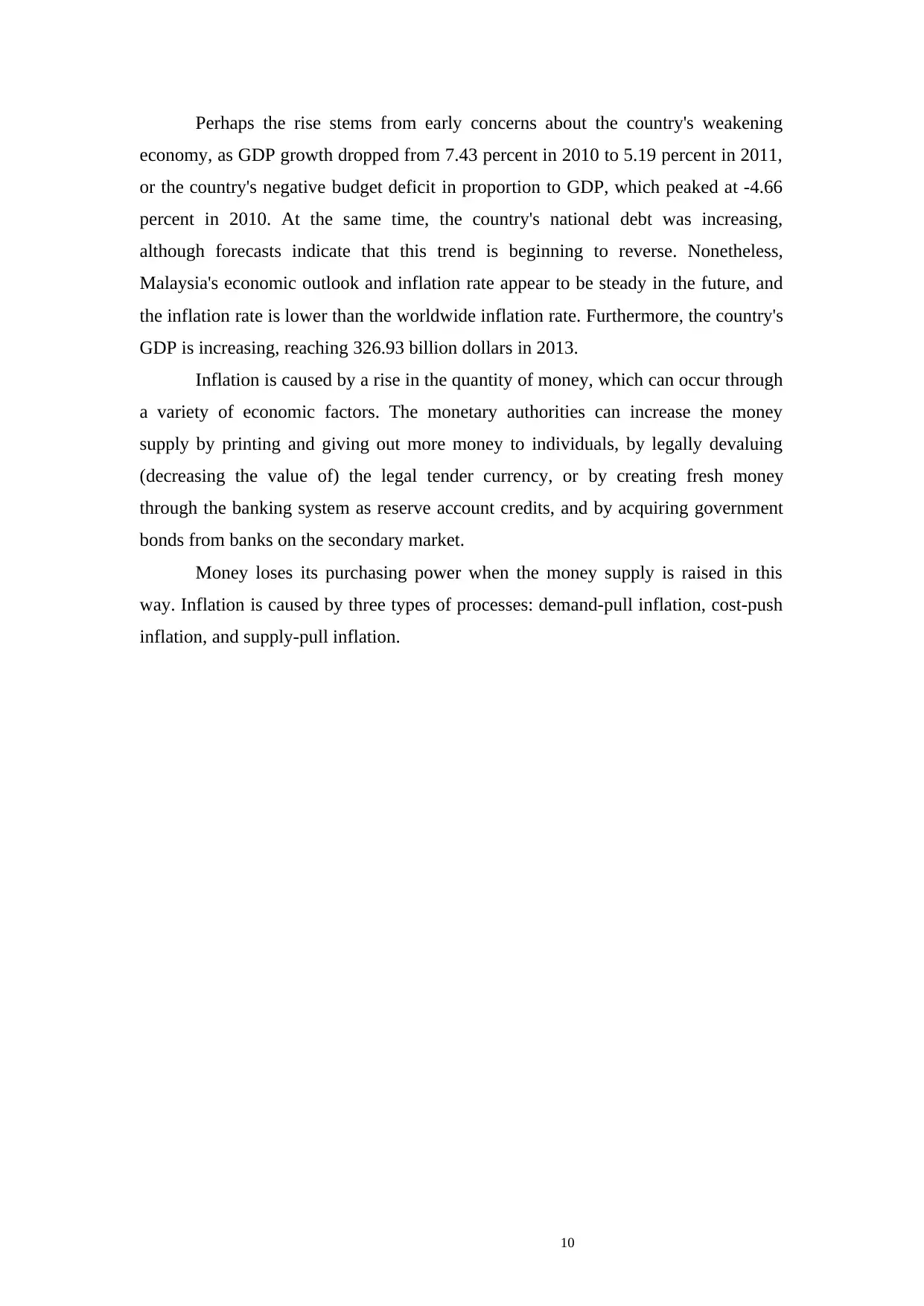
10
Perhaps the rise stems from early concerns about the country's weakening
economy, as GDP growth dropped from 7.43 percent in 2010 to 5.19 percent in 2011,
or the country's negative budget deficit in proportion to GDP, which peaked at -4.66
percent in 2010. At the same time, the country's national debt was increasing,
although forecasts indicate that this trend is beginning to reverse. Nonetheless,
Malaysia's economic outlook and inflation rate appear to be steady in the future, and
the inflation rate is lower than the worldwide inflation rate. Furthermore, the country's
GDP is increasing, reaching 326.93 billion dollars in 2013.
Inflation is caused by a rise in the quantity of money, which can occur through
a variety of economic factors. The monetary authorities can increase the money
supply by printing and giving out more money to individuals, by legally devaluing
(decreasing the value of) the legal tender currency, or by creating fresh money
through the banking system as reserve account credits, and by acquiring government
bonds from banks on the secondary market.
Money loses its purchasing power when the money supply is raised in this
way. Inflation is caused by three types of processes: demand-pull inflation, cost-push
inflation, and supply-pull inflation.
Perhaps the rise stems from early concerns about the country's weakening
economy, as GDP growth dropped from 7.43 percent in 2010 to 5.19 percent in 2011,
or the country's negative budget deficit in proportion to GDP, which peaked at -4.66
percent in 2010. At the same time, the country's national debt was increasing,
although forecasts indicate that this trend is beginning to reverse. Nonetheless,
Malaysia's economic outlook and inflation rate appear to be steady in the future, and
the inflation rate is lower than the worldwide inflation rate. Furthermore, the country's
GDP is increasing, reaching 326.93 billion dollars in 2013.
Inflation is caused by a rise in the quantity of money, which can occur through
a variety of economic factors. The monetary authorities can increase the money
supply by printing and giving out more money to individuals, by legally devaluing
(decreasing the value of) the legal tender currency, or by creating fresh money
through the banking system as reserve account credits, and by acquiring government
bonds from banks on the secondary market.
Money loses its purchasing power when the money supply is raised in this
way. Inflation is caused by three types of processes: demand-pull inflation, cost-push
inflation, and supply-pull inflation.
Paraphrase This Document
Need a fresh take? Get an instant paraphrase of this document with our AI Paraphraser
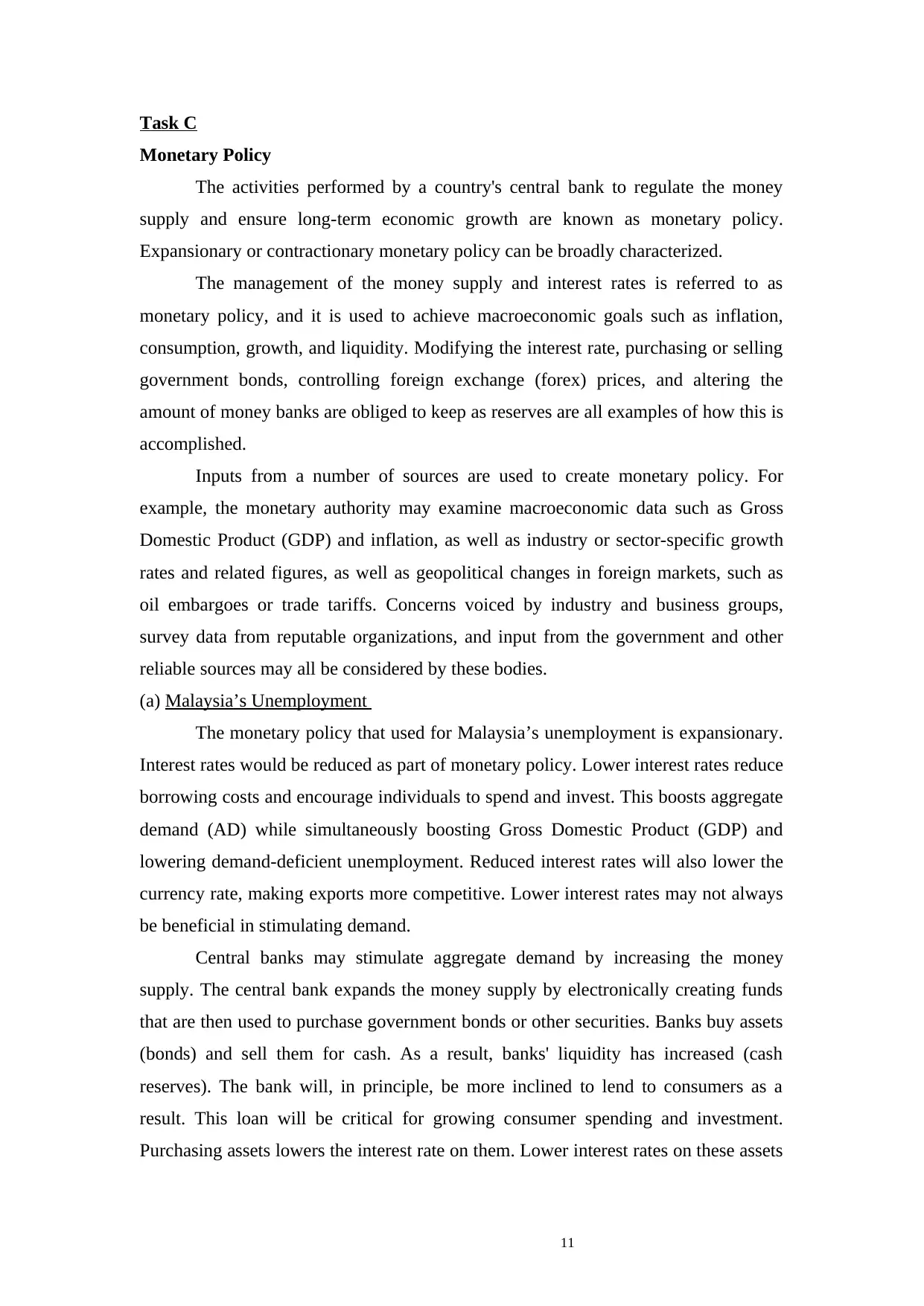
11
Task C
Monetary Policy
The activities performed by a country's central bank to regulate the money
supply and ensure long-term economic growth are known as monetary policy.
Expansionary or contractionary monetary policy can be broadly characterized.
The management of the money supply and interest rates is referred to as
monetary policy, and it is used to achieve macroeconomic goals such as inflation,
consumption, growth, and liquidity. Modifying the interest rate, purchasing or selling
government bonds, controlling foreign exchange (forex) prices, and altering the
amount of money banks are obliged to keep as reserves are all examples of how this is
accomplished.
Inputs from a number of sources are used to create monetary policy. For
example, the monetary authority may examine macroeconomic data such as Gross
Domestic Product (GDP) and inflation, as well as industry or sector-specific growth
rates and related figures, as well as geopolitical changes in foreign markets, such as
oil embargoes or trade tariffs. Concerns voiced by industry and business groups,
survey data from reputable organizations, and input from the government and other
reliable sources may all be considered by these bodies.
(a) Malaysia’s Unemployment
The monetary policy that used for Malaysia’s unemployment is expansionary.
Interest rates would be reduced as part of monetary policy. Lower interest rates reduce
borrowing costs and encourage individuals to spend and invest. This boosts aggregate
demand (AD) while simultaneously boosting Gross Domestic Product (GDP) and
lowering demand-deficient unemployment. Reduced interest rates will also lower the
currency rate, making exports more competitive. Lower interest rates may not always
be beneficial in stimulating demand.
Central banks may stimulate aggregate demand by increasing the money
supply. The central bank expands the money supply by electronically creating funds
that are then used to purchase government bonds or other securities. Banks buy assets
(bonds) and sell them for cash. As a result, banks' liquidity has increased (cash
reserves). The bank will, in principle, be more inclined to lend to consumers as a
result. This loan will be critical for growing consumer spending and investment.
Purchasing assets lowers the interest rate on them. Lower interest rates on these assets
Task C
Monetary Policy
The activities performed by a country's central bank to regulate the money
supply and ensure long-term economic growth are known as monetary policy.
Expansionary or contractionary monetary policy can be broadly characterized.
The management of the money supply and interest rates is referred to as
monetary policy, and it is used to achieve macroeconomic goals such as inflation,
consumption, growth, and liquidity. Modifying the interest rate, purchasing or selling
government bonds, controlling foreign exchange (forex) prices, and altering the
amount of money banks are obliged to keep as reserves are all examples of how this is
accomplished.
Inputs from a number of sources are used to create monetary policy. For
example, the monetary authority may examine macroeconomic data such as Gross
Domestic Product (GDP) and inflation, as well as industry or sector-specific growth
rates and related figures, as well as geopolitical changes in foreign markets, such as
oil embargoes or trade tariffs. Concerns voiced by industry and business groups,
survey data from reputable organizations, and input from the government and other
reliable sources may all be considered by these bodies.
(a) Malaysia’s Unemployment
The monetary policy that used for Malaysia’s unemployment is expansionary.
Interest rates would be reduced as part of monetary policy. Lower interest rates reduce
borrowing costs and encourage individuals to spend and invest. This boosts aggregate
demand (AD) while simultaneously boosting Gross Domestic Product (GDP) and
lowering demand-deficient unemployment. Reduced interest rates will also lower the
currency rate, making exports more competitive. Lower interest rates may not always
be beneficial in stimulating demand.
Central banks may stimulate aggregate demand by increasing the money
supply. The central bank expands the money supply by electronically creating funds
that are then used to purchase government bonds or other securities. Banks buy assets
(bonds) and sell them for cash. As a result, banks' liquidity has increased (cash
reserves). The bank will, in principle, be more inclined to lend to consumers as a
result. This loan will be critical for growing consumer spending and investment.
Purchasing assets lowers the interest rate on them. Lower interest rates on these assets
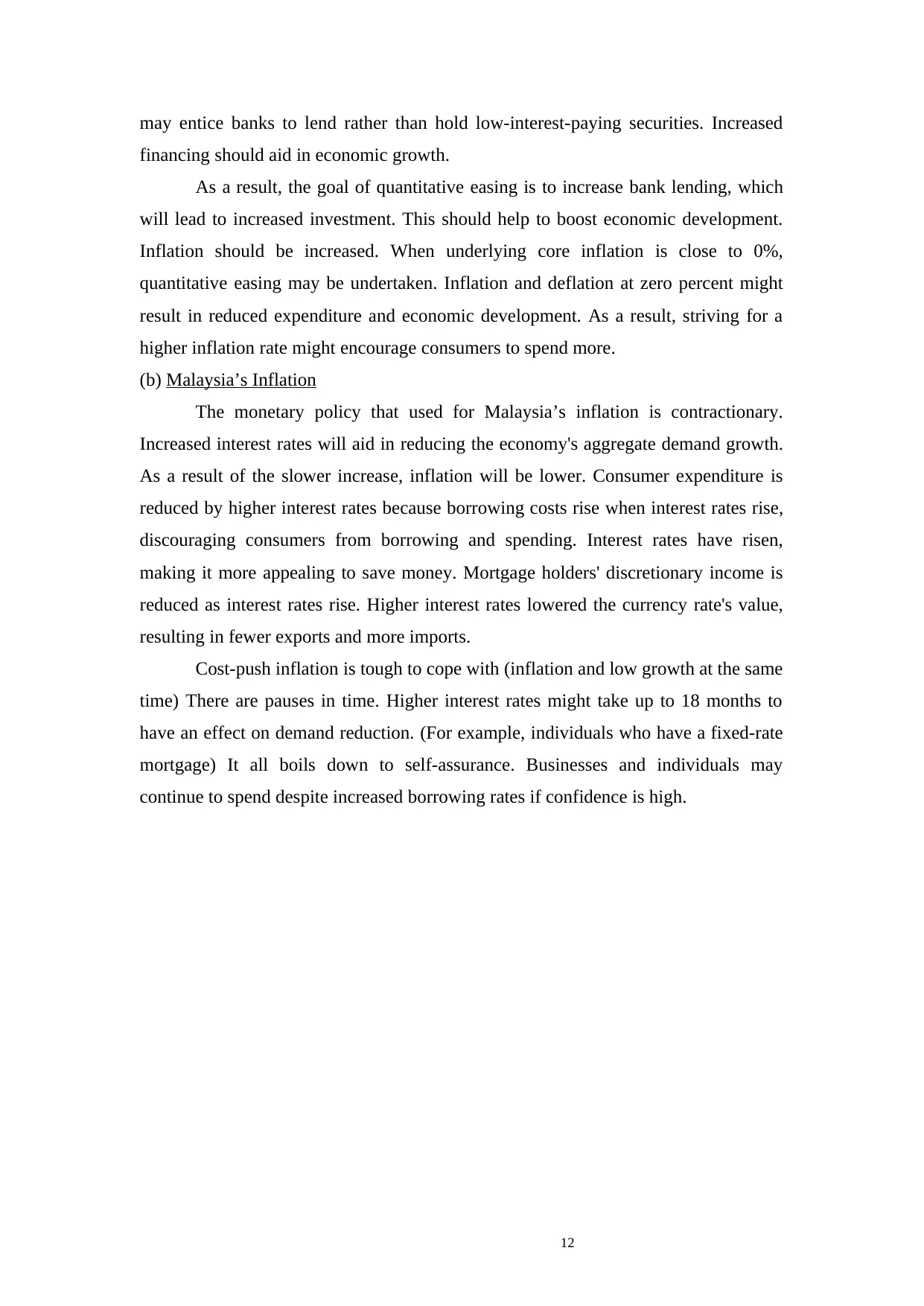
12
may entice banks to lend rather than hold low-interest-paying securities. Increased
financing should aid in economic growth.
As a result, the goal of quantitative easing is to increase bank lending, which
will lead to increased investment. This should help to boost economic development.
Inflation should be increased. When underlying core inflation is close to 0%,
quantitative easing may be undertaken. Inflation and deflation at zero percent might
result in reduced expenditure and economic development. As a result, striving for a
higher inflation rate might encourage consumers to spend more.
(b) Malaysia’s Inflation
The monetary policy that used for Malaysia’s inflation is contractionary.
Increased interest rates will aid in reducing the economy's aggregate demand growth.
As a result of the slower increase, inflation will be lower. Consumer expenditure is
reduced by higher interest rates because borrowing costs rise when interest rates rise,
discouraging consumers from borrowing and spending. Interest rates have risen,
making it more appealing to save money. Mortgage holders' discretionary income is
reduced as interest rates rise. Higher interest rates lowered the currency rate's value,
resulting in fewer exports and more imports.
Cost-push inflation is tough to cope with (inflation and low growth at the same
time) There are pauses in time. Higher interest rates might take up to 18 months to
have an effect on demand reduction. (For example, individuals who have a fixed-rate
mortgage) It all boils down to self-assurance. Businesses and individuals may
continue to spend despite increased borrowing rates if confidence is high.
may entice banks to lend rather than hold low-interest-paying securities. Increased
financing should aid in economic growth.
As a result, the goal of quantitative easing is to increase bank lending, which
will lead to increased investment. This should help to boost economic development.
Inflation should be increased. When underlying core inflation is close to 0%,
quantitative easing may be undertaken. Inflation and deflation at zero percent might
result in reduced expenditure and economic development. As a result, striving for a
higher inflation rate might encourage consumers to spend more.
(b) Malaysia’s Inflation
The monetary policy that used for Malaysia’s inflation is contractionary.
Increased interest rates will aid in reducing the economy's aggregate demand growth.
As a result of the slower increase, inflation will be lower. Consumer expenditure is
reduced by higher interest rates because borrowing costs rise when interest rates rise,
discouraging consumers from borrowing and spending. Interest rates have risen,
making it more appealing to save money. Mortgage holders' discretionary income is
reduced as interest rates rise. Higher interest rates lowered the currency rate's value,
resulting in fewer exports and more imports.
Cost-push inflation is tough to cope with (inflation and low growth at the same
time) There are pauses in time. Higher interest rates might take up to 18 months to
have an effect on demand reduction. (For example, individuals who have a fixed-rate
mortgage) It all boils down to self-assurance. Businesses and individuals may
continue to spend despite increased borrowing rates if confidence is high.
⊘ This is a preview!⊘
Do you want full access?
Subscribe today to unlock all pages.

Trusted by 1+ million students worldwide
1 out of 16
Related Documents
Your All-in-One AI-Powered Toolkit for Academic Success.
+13062052269
info@desklib.com
Available 24*7 on WhatsApp / Email
![[object Object]](/_next/static/media/star-bottom.7253800d.svg)
Unlock your academic potential
Copyright © 2020–2025 A2Z Services. All Rights Reserved. Developed and managed by ZUCOL.





